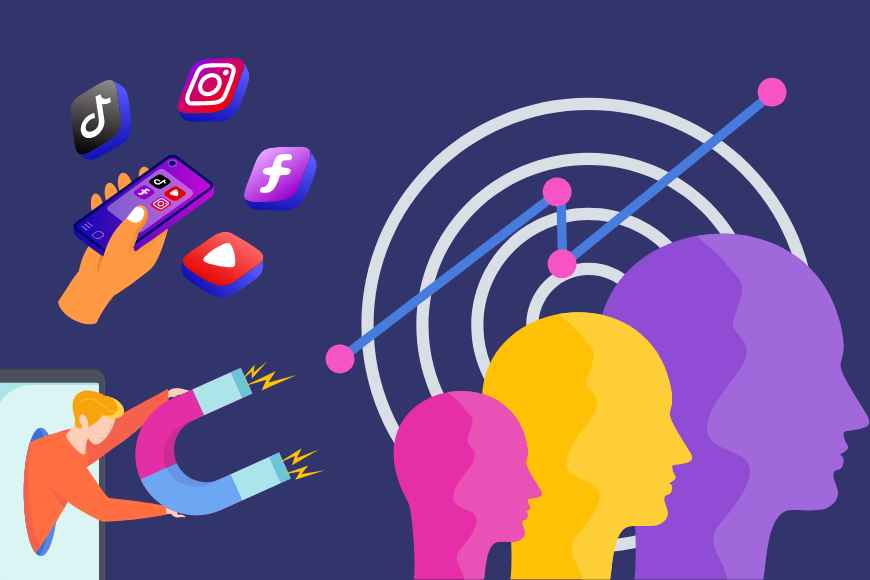Developing a comprehensive social media strategy is criticial because it serves as a blueprint for your marketing efforts.

Crafting a Social Media Strategy: Why is it Essential?
Why is it necessary to develop a social media strategy before diving into social media marketing?
Developing a comprehensive social media strategy is criticial because it serves as a blueprint for your marketing efforts. It ensures that your campaigns are well-organized, targeted, and purposeful, ultimately leading to higher success rates. A well-defined strategy helps you stay focused on your objectives, allocate resources efficiently, and measure the performance of your initiatives, allowing you to make informed decisions and adjust your approach when needed.
STRATEGY: You know, strategy is like a master plan we make to reach our goals by using what we’ve got and thinking about what’s happening around us. We figure out what’s important, decide on our targets, and plan our steps to get there. It helps us deal with the unexpected, use our resources wisely, and stay ahead in this ever-changing world.
Think of your social media strategy as a roadmap for a road trip. Without a clear route, you might get lost, waste time, and miss out on your desired destination. But with a well-planned itinerary, you can effectively navigate your journey, make the most out of your resources, and reach your goals without any unnecessary detours or setbacks.
- Crafting a Social Media Strategy: Why is it Essential?
- Why is it necessary to develop a social media strategy before diving into social media marketing?
- Establishing Clear Goals and Objectives in Social Media Strategy
- Pinpointing Your Target Audience in Social Media Strategy
- Selecting the Right Platforms for Your Social Media Strategy
- The Importance of a Content Calendar in Social Media Strategy
- The Importance of Developing Engaging Content for Your Social Media Strategy
- Take advantage of the Power of User-Generated Content in Social Media Strategy
- Boosting User-Generated Content Through Contests and Giveaways in Social Media Strategy
- Promoting Customer Success Stories in Your Social Media Strategy
- Embracing Live Streaming in Your Social Media Strategy
- Strengthening Your Social Media Strategy with Q&A Sessions
- Enhancing Social Media Strategy by Showcasing Product Launches and Events
- Capitalizing on Stories and Ephemeral Content in Social Media Strategy
- Make Use of Daily Updates and Insights in Your Social Media Strategy
- Boosting Engagement with Interactive Content in Your Social Media Strategy
- Amplifying Your Social Media Strategy with Influencers and Partnerships
- Finding the Right Influencers for Your Social Media Strategy
- Building Mutually Beneficial Partnerships in Your Social Media Strategy
- The Importance of Tracking and Measuring Results in Your Social Media Strategy
- Harnessing the Power of Social Media Advertising in Your Strategy
- Exploring the Diversity of Ad Formats on Facebook, Instagram, LinkedIn, and Pinterest
- The Significance of Analyzing Metrics in Your Social Media Strategy
- The Importance of Responding to Comments and Messages in Your Social Media Strategy
- The Value of Data-Driven Adjustments in Your Social Media Strategy

Establishing Clear Goals and Objectives in Social Media Strategy
Why is it important to set clear goals and objectives when creating a social media strategy?
Setting clear goals and objectives is vital because they serve as the foundation for your social media strategy. By defining specific targets, you can ensure that your marketing efforts are aligned with your desired outcomes, such as increasing brand awareness, generating leads, or improving customer engagement. Clear goals and objectives also enable you to measure the success of your campaigns, helping you identify areas for improvement and adjust your tactics accordingly.
Imagine your social media strategy as a ship setting sail. Your goals and objectives are the compass that guides your ship towards its destination. Without a compass, you might drift aimlessly, never reaching your desired outcomes or making progress. However, with a clear set of goals and objectives, you can steer your ship with purpose, charting a course that leads to the achievement of your marketing aims.
Pinpointing Your Target Audience in Social Media Strategy

Why is it essential to identify your target audience when crafting a social media strategy, and how can this information be used?
Identifying your target audience is a critical component of a successful social media strategy. By understanding who your ideal customers are and recognizing their preferences, needs, and pain points, you can create tailored content that resonates with them. This allows you to establish a connection with your audience, fostering trust and loyalty, and increasing the likelihood of engagement and conversions.
Think of your target audience as the key that unlocks the door to your marketing success. You wouldn’t attempt to open a door with the wrong key, as it would lead to wasted time and effort. Similarly, creating content without knowing your target audience is like using the wrong key – it’s unlikely to yield the desired results. By understanding your audience, you can craft content that acts as the right key, effectively unlocking the door to their needs and interests.
Example: Suppose you run a health and fitness business, and your target audience consists of young adults interested in improving their physical well-being. In this case, you should create content that addresses their specific preferences and pain points, such as workout routines, healthy meal plans, and tips for maintaining motivation. By tailoring your content to your audience, you’ll be more likely to engage them and convert them into loyal customers
Selecting the Right Platforms for Your Social Media Strategy

Why is it important to choose the right social media platforms for your strategy, and how can you determine which platforms are best suited for your target audience and objectives?
Choosing the right social media platforms is crucial for the effectiveness of your strategy. Each platform has its own demographics, user behaviors, and content preferences, making some better suited for certain target audiences and objectives than others. By selecting the platforms that align with your target audience and goals, you can increase your chances of reaching and engaging potential customers, as well as optimizing your marketing efforts.
Choosing the right social media platforms is like picking the appropriate fishing spot. If you want to catch a specific type of fish, you need to know where they’re most likely to be found. In the same vein, you need to identify the social media platforms where your target audience is most active and engaged in order to effectively reach them.
Example: Suppose your target audience consists of professionals in their 30s seeking career advancement. In this case, LinkedIn would likely be a more appropriate platform for your marketing efforts than Instagram or Snapchat, which caters to a younger demographic with different interests. By focusing your efforts on LinkedIn, you can create content that appeals to your target audience, such as industry insights, networking tips, and job opportunities, ultimately increasing the likelihood of achieving your objectives.
The Importance of a Content Calendar in Social Media Strategy

Why is it essential to develop a content calendar as part of your social media strategy, and how can it contribute to your online presence?
Developing a content calendar is a critical aspect of a successful social media strategy. A content calendar helps you plan and schedule your posts, ensuring a consistent flow of high-quality, engaging material for your audience. Consistency in posting helps maintain a strong online presence, which in turn fosters trust and credibility with your audience. It also helps you avoid last-minute content creation, allowing you to produce well-thought-out and relevant content.
Think of a content calendar as the meal plan for your social media strategy. Just like meal planning ensures you have a balanced, nutritious diet throughout the week, a content calendar ensures that your social media presence remains consistent and engaging. It allows you to allocate the right resources, ingredients, and time to create content that nourishes your audience and keeps them coming back for more.
Example: If you’re managing a social media account for a fashion brand, your content calendar might include weekly outfit inspiration posts, style tips, new product launches, and customer testimonials. By planning and scheduling these posts in advance, you can ensure a steady flow of engaging content that appeals to your target audience, keeps your brand top-of-mind, and drives engagement and conversions.
The Importance of Developing Engaging Content for Your Social Media Strategy

Why is developing captivating content crucial for social media success, and what are some effective content formats to consider?
Developing engaging content is vital for social media success because it grabs users’ attention and encourages interaction, which helps build brand awareness, foster relationships, and drive desired actions. Content that resonates with your audience increases the likelihood of shares, likes, and comments, ultimately boosting your online presence and helping you achieve your marketing objectives.
Consider captivating content as the magnet that attracts and retains people at a social event. Just as a fascinating conversation or entertaining performance draws people in and keeps them engaged, high-quality social media content attracts your audience’s attention, keeps them interested, and encourages them to interact with your brand.
Here are some effective content formats to consider for your social media strategy:
Informative Blog Posts: Share valuable information or insights on topics relevant to your industry, positioning your brand as an expert and providing value to your audience. For example, a marketing agency can share blog posts about best practices for SEO, social media advertising, or content marketing, helping potential clients understand the benefits of these services.
Eye-catching Visuals: Use visually appealing graphics, images, or videos to communicate your message and grab users’ attention. For instance, a travel agency can share stunning images of popular destinations, accompanied by brief descriptions and travel tips, inspiring their audience to explore and consider their services.
How-to Videos: Create instructional videos that teach your audience how to accomplish a task or use your product effectively. For example, a software company can create short tutorials demonstrating how to use their product’s features, helping users understand its value and benefits.
User-Generated Content: Share content created by your customers or followers, such as testimonials, reviews, or photos featuring your products or services. This not only provides social proof but also encourages other users to share their own experiences with your brand. For instance, a fitness brand can repost customer photos of workout progress or success stories, motivating others to engage with the brand and join their fitness community.
Take advantage of the Power of User-Generated Content in Social Media Strategy

Why is user-generated content (UGC) a valuable component of a social media strategy, and how can it impact engagement and trust?
User-generated content (UGC) is highly influential because it showcases genuine experiences and opinions from your audience, such as reviews, testimonials, or photos featuring your products or services. UGC can drive significant engagement and trust as it provides social proof of your brand’s value, making potential customers more likely to believe in your offerings and engage with your content. Incorporating UGC into your social media strategy can also foster a sense of community and encourage further audience interaction.
Think of user-generated content as word-of-mouth marketing in the digital world. Just as personal recommendations from friends and family can be more persuasive than traditional advertisements, UGC carries a similar sense of authenticity and trustworthiness. By sharing content created by your audience, you are tapping into the power of digital word-of-mouth, amplifying your brand’s credibility and reach.
Example: A skincare company could encourage their customers to share before-and-after photos of their skin transformation using the company’s products. By sharing these user-generated images on the brand’s social media accounts, they can demonstrate the effectiveness of their products through real-life examples. This can inspire trust and confidence in potential customers, leading to increased engagement and conversions.
Boosting User-Generated Content Through Contests and Giveaways in Social Media Strategy
Why are contests and giveaways effective methods for encouraging user-generated content (UGC) in your social media strategy, and how can they benefit your brand?
Contests and giveaways are powerful tools for motivating your audience to create and submit their own content. By offering attractive prizes, you can incentivize users to participate, which can result in increased engagement, brand exposure, and user-generated content. These campaigns can also create a sense of excitement and community around your brand, further strengthening your connection with your audience.
Think of contests and giveaways as a catalyst for sparking audience creativity and involvement. Just as adding fuel to a fire can make it burn brighter and faster, contests and giveaways can ignite user interest and participation, generating a surge of UGC and brand engagement.
Example: A travel agency could organize a photo contest asking their followers to submit their best vacation photos with a branded hashtag. Participants can enter the contest for a chance to win a free trip or travel-related prizes. By hosting this contest, the travel agency not only generates a wealth of UGC showcasing the experiences of their customers but also amplifies their brand exposure as users share their photos with their networks. This can lead to increased brand awareness, engagement, and potential new customers.
Promoting Customer Success Stories in Your Social Media Strategy
Why is sharing customer success stories important in a social media strategy, and how can it benefit your brand?
Sharing customer success stories is a powerful way to provide social proof and demonstrate the value of your products or services. By featuring customers who have benefitted from your offerings, you can showcase their experiences and results, which can be persuasive to potential customers. In addition, sharing these stories fosters a sense of community and connection, making your audience feel valued and understood.
Think of customer success stories as the highlight reel of your brand’s accomplishments. Just as a sports team showcases their best plays to demonstrate their skill and win over fans, sharing customer success stories allows you to display your brand’s effectiveness and build trust with your audience.
Example: A weight loss program could share customer success stories by posting before-and-after photos and testimonials from clients who have achieved their goals using the program. By highlighting these real-life examples, the brand can showcase the efficacy of their program, inspiring trust and confidence in potential customers. Additionally, this content can foster a sense of community among followers, as they witness and celebrate the successes of others on the same journey.
Embracing Live Streaming in Your Social Media Strategy

Why is live streaming an effective method for connecting with your audience in a social media strategy, and how can it benefit your brand?
Live streaming is a powerful way to connect with your audience in real-time, as it fosters authenticity and encourages interaction. By broadcasting live, you can engage with viewers on a personal level, allowing them to ask questions or leave comments during the stream. This direct communication builds trust, humanizes your brand, and helps you gain valuable insights into your audience’s preferences and concerns.
Think of live streaming as hosting an open house for your brand. Just as an open house allows potential buyers to explore a property and engage with the host directly, live streaming invites your audience to interact with your brand in a genuine and unfiltered way. This intimate connection can make your audience feel valued and heard, ultimately fostering loyalty and trust.
Example: A cooking blog could host a live streaming session where they prepare a recipe from start to finish. During the broadcast, viewers can ask questions about ingredients, techniques, or substitutions, and the host can address these inquiries in real-time. By providing this interactive experience, the cooking blog can create a more personal connection with their audience, increasing engagement and loyalty, while also gathering feedback and insights to inform future content.
Strengthening Your Social Media Strategy with Q&A Sessions
Why are Q&A sessions an effective way to enhance your social media strategy, and how can they benefit your brand?
Hosting live Q&A sessions is a valuable approach for addressing customer concerns, demonstrating your expertise, and deepening relationships with your audience. By providing direct answers to questions, you can resolve issues, offer advice, and showcase your brand’s knowledge and authority. Furthermore, these sessions enable you to engage with your audience in a personalized and interactive manner, which can foster trust and loyalty.
Think of Q&A sessions as a town hall meeting for your brand. Just as a town hall meeting allows community members to voice their concerns and receive answers from local officials, a Q&A session invites your audience to express their questions and receive direct responses from your brand. This transparent exchange of information can strengthen your audience’s trust and satisfaction, leading to stronger brand relationships.
Example: A software company could host a live Q&A session on social media, inviting users to ask questions about product features, functionality, and upcoming updates. By addressing these questions in real-time, the company can showcase their expertise, resolve user concerns, and gather valuable feedback for future improvements. This interaction can lead to increased customer satisfaction and brand loyalty, as well as providing insights to inform the company’s ongoing development and communication efforts.
Enhancing Social Media Strategy by Showcasing Product Launches and Events
Why is it beneficial to use live streaming for showcasing product launches and events in your social media strategy, and how can it impact your audience’s experience?
Live streaming product launches, tutorials, and events offers your audience a front-row seat to your brand’s latest happenings, creating a sense of excitement and exclusivity. By inviting your audience to experience these moments in real-time, you can build anticipation, generate buzz, and foster engagement. Moreover, this approach can help demonstrate your brand’s commitment to transparency and communication, strengthening the bond between your brand and its followers.
Consider live streaming product launches and events as the red carpet experience for your audience. Just as a red carpet event generates excitement and anticipation for a movie premiere or awards show, live streaming your brand’s activities can create a similar sense of enthusiasm and inclusion, making your audience feel like VIPs in your brand’s story.
Example: A cosmetics company could use live streaming to unveil their new makeup line, providing product demonstrations and tutorials during the event. By broadcasting this launch in real-time, the company can create anticipation and excitement around their new products, encourage audience interaction and feedback, and generate immediate interest and buzz. This interactive experience can lead to increased engagement, brand loyalty, and ultimately, higher sales.
Capitalizing on Stories and Ephemeral Content in Social Media Strategy

Why are stories and ephemeral content valuable components of a social media strategy, and how can they benefit your brand?
Stories and ephemeral content are short-lived posts that vanish after 24 hours, providing a unique way to engage with your audience. This format encourages users to interact quickly and offers a more casual, behind-the-scenes glimpse of your brand. The fleeting nature of stories creates a sense of urgency and exclusivity, making your audience more likely to engage with your content. Additionally, stories offer an informal and authentic way to communicate with your followers, which can strengthen brand connections and loyalty.
Think of stories and ephemeral content as pop-up shops for your brand. Just as pop-up shops generate excitement and interest due to their temporary nature, stories and ephemeral content pique audience curiosity and encourage swift engagement before the content disappears.
Example: A fitness studio could use Instagram Stories to share daily workout tips, behind-the-scenes footage of their classes, or quick interviews with trainers and clients. By providing this ephemeral content, the fitness studio can offer an authentic, unfiltered look at their brand, making their audience feel more connected and engaged. The time-sensitive nature of stories can also encourage followers to regularly check in with the studio’s content, increasing the likelihood of long-term engagement and loyalty.
Make Use of Daily Updates and Insights in Your Social Media Strategy
Why is it important to share daily updates and insights through stories in your social media strategy, and how can it benefit your brand?
Sharing daily updates and insights using stories allows you to give your audience a glimpse into your brand’s day-to-day operations, highlighting milestones, challenges, or exciting developments. This transparency fosters a sense of authenticity and trust, as your followers gain a better understanding of your brand’s journey and values. Regular updates can also keep your audience engaged and interested, strengthening brand loyalty and fostering a sense of connection.
Consider daily updates and insights as a behind-the-scenes documentary for your brand. Just as a documentary provides an intimate look at the subject’s life and experiences, sharing daily updates allows your audience to see the inner workings of your brand, making them feel more connected and invested in your success.
Example: A small organic vegetarian restaurant could use stories to share daily updates on their menu creation process, ingredient sourcing, or even the challenges they face in running their business. By providing insights into their operations, the restaurant can foster a sense of authenticity and trust with their audience. This transparency can lead to increased customer loyalty and a deeper understanding of the brand’s values and mission, ultimately differentiating the vegetarian restaurant from competitors and building a strong community around their brand.
Boosting Engagement with Interactive Content in Your Social Media Strategy

Why is creating interactive content, such as polls, quizzes, or countdowns, important for your social media strategy, and how can it benefit your brand?
Incorporating interactive content like polls, quizzes, or countdowns into your stories is a powerful way to encourage audience interaction and gather valuable feedback. This type of content actively engages your followers, making them feel more connected to your brand and fostering a sense of community. Interactive content can also provide insights into your audience’s preferences and opinions, helping you make informed decisions about your products, services, or content direction.
Think of interactive content as a game show for your brand. Just as game shows engage viewers by inviting them to participate and test their knowledge, interactive content invites your audience to actively engage with your brand, making them feel involved and valued. This active participation can lead to increased brand loyalty and a better understanding of your audience’s needs.
Example: A clothing retailer could use Instagram Stories to create a poll, asking followers to choose between two potential new clothing designs. By incorporating this interactive content, the retailer encourages their audience to engage with their brand and voice their opinions. The feedback collected from the poll can help the retailer make data-driven decisions about their product offerings, while also fostering a sense of community and involvement among their followers.
Amplifying Your Social Media Strategy with Influencers and Partnerships

Why is leveraging influencers and establishing partnerships crucial for a successful social media strategy, and how can it benefit your brand?
Collaborating with influencers and forming partnerships can significantly expand your reach and credibility. Influencers often have a dedicated and engaged following, which can help your brand tap into new audiences and increase brand awareness. Additionally, their endorsement can enhance your brand’s perceived value and trustworthiness, as potential customers are more likely to trust recommendations from someone they follow and respect.
Think of influencers and partnerships as guest speakers at an event. Just as guest speakers can attract more attendees and lend credibility to the event, influencers and partners can draw in new followers and bolster your brand’s reputation. This expanded reach and credibility can ultimately lead to increased brand awareness and customer conversions.
Example: A startup that produces eco-friendly skincare products could partner with a popular beauty influencer to create a sponsored Instagram post, showcasing the benefits and effectiveness of their products. By collaborating with the influencer, the brand can tap into their established audience, generating interest and awareness among potential customers who share similar values and interests. This partnership can also enhance the brand’s credibility, as the influencer’s endorsement can influence their followers’ perception of the products and increase the likelihood of purchases.
Finding the Right Influencers for Your Social Media Strategy
Why is it important to identify influencers that align with your brand’s values and target audience, and how can this contribute to the success of your social media strategy?
Identifying influencers who align with your brand’s values and have a following that matches your target audience is crucial for the effectiveness of your influencer marketing efforts. By partnering with relevant influencers, you ensure that your brand’s message resonates with their audience, leading to increased engagement and potential customer conversions. Moreover, working with influencers who share your values strengthens your brand’s image and credibility, resulting in a more authentic and trustworthy collaboration.
Consider the process of identifying relevant influencers as casting actors for a movie. Just as casting the right actors can make a movie more compelling and believable, partnering with the right influencers can make your brand’s message more appealing and persuasive to their followers. By selecting influencers who fit your brand’s values and target audience, you increase the likelihood of a successful marketing campaign
Example: An outdoor gear company that focuses on sustainability should look for influencers who are passionate about environmental conservation and have a following of outdoor enthusiasts. By partnering with these influencers, the company can ensure that their brand message resonates with the influencer’s audience, leading to increased engagement and higher chances of converting followers into customers. This collaboration will also reinforce the company’s commitment to sustainability, as the influencer’s values align with the brand’s mission.
Building Mutually Beneficial Partnerships in Your Social Media Strategy
Why is it essential to develop mutually beneficial partnerships, and how can this contribute to the success of your social media strategy?
Establishing mutually beneficial partnerships ensures that both parties receive value from the collaboration, increasing the likelihood of a successful and long-lasting relationship. By offering value to your partners, such as co-branded content, product collaborations, or affiliate programs, you create a win-win situation that encourages both parties to invest in the partnership and achieve better results. These collaborations can lead to increased brand exposure, credibility, and customer loyalty for both parties involved.
Consider mutually beneficial partnerships as a potluck dinner. Just as each guest brings a dish to contribute to the meal, ensuring that everyone enjoys a variety of food, mutually beneficial partnerships require each party to offer value, ensuring that both parties benefit from the collaboration. This shared investment in the partnership leads to more successful outcomes and stronger relationships.
Example: A fitness apparel company could partner with a popular fitness app to create a co-branded workout program, combining the company’s stylish workout gear with the app’s comprehensive fitness tracking and coaching features. By offering value to both parties, this partnership can attract new customers for both the apparel company and the fitness app, increasing brand exposure and credibility for both brands. Additionally, this collaboration could lead to further opportunities, such as affiliate marketing programs or exclusive product discounts for app subscribers, strengthening the partnership and driving continued success.
The Importance of Tracking and Measuring Results in Your Social Media Strategy

Why is it vital to track and measure the results of your influencer campaigns, and how can this contribute to the success of your social media strategy?
Tracking and measuring the results of your influencer campaigns allows you to assess their effectiveness and make informed decisions about your social media strategy. By monitoring key performance indicators (KPIs), such as engagement, reach, and conversion rates, you can identify which aspects of your campaigns are working well and which areas require improvement. This data-driven approach helps you optimize your strategy, allocate resources more effectively, and achieve better results over time.
Think of tracking and measuring results as a GPS for your social media strategy. Just as a GPS helps you navigate and adjust your route based on real-time information, tracking and measuring results enable you to fine-tune your strategy based on actual performance data. This continuous feedback loop ensures that your campaigns stay on track and reach their desired goals.
Example: An online clothing store partners with several fashion influencers to promote their new clothing line. By tracking metrics such as engagement rates, website traffic, and sales conversions attributed to each influencer, the store can determine which partnerships are most effective and adjust their strategy accordingly. For instance, if one influencer generates significantly higher engagement and sales than the others, the store might choose to allocate more resources to that partnership or adjust their content and targeting strategies to better align with the successful influencer’s audience. This data-driven approach allows the store to optimize its campaigns and maximize its return on investment.
Harnessing the Power of Social Media Advertising in Your Strategy
Why is using social media advertising important for your social media strategy, and how can it contribute to your brand’s success?
Social media advertising is a powerful tool that can help you reach a larger audience, drive website traffic, and increase conversions. By leveraging the advertising options offered by various platforms, you can precisely target your desired demographic, ensuring that your ads reach potential customers who are most likely to be interested in your products or services. This targeted approach can lead to more efficient use of your advertising budget, resulting in higher returns on investment and greater brand exposure.
Think of social media advertising as a spotlight in a crowded room. Just as a spotlight draws attention to a specific person or object amidst a sea of people, social media advertising helps your brand stand out in the crowded online landscape, ensuring that your message reaches the right people at the right time.
Here are two examples of popular social media advertising options:
Facebook Ads: A local bakery could use Facebook Ads to target users within a specific radius of their store, who have shown an interest in baking or dessert-related content. By creating a targeted ad campaign featuring a special promotion, the bakery can attract new customers and increase foot traffic to their store.
Instagram Sponsored Posts: A clothing brand could collaborate with fashion influencers to create sponsored Instagram posts, showcasing their latest collection. By leveraging the influencer’s reach and credibility, the brand can increase awareness and drive potential customers to their website or physical store, resulting in higher sales and conversions.
Exploring the Diversity of Ad Formats on Facebook, Instagram, LinkedIn, and Pinterest

Why is it important to consider the wide range of ad formats, targeting options, and placements offered by Facebook, Instagram, LinkedIn, and Pinterest, and how can these contribute to the success of your social media strategy?
The diverse range of ad formats, targeting options, and placements offered by Facebook, Instagram, LinkedIn, and Pinterest allows you to tailor your advertising efforts to your specific marketing objectives and target audience. By selecting the appropriate ad formats and targeting, you can create highly effective campaigns that resonate with your audience and achieve your desired goals, whether it’s brand awareness, lead generation, or increased sales. This flexibility enables you to optimize your advertising efforts and maximize the return on investment.
Think of the various ad formats, targeting options, and placements as a painter’s palette. Just as a painter can mix different colors and techniques to create the perfect artwork, marketers can combine various advertising elements to craft the ideal campaign for their specific marketing objectives and target audience.
Examples: Here are examples of ad formats on each platform and how they can be used effectively:
Facebook Carousel Ads: A travel agency could use Carousel Ads to showcase a series of stunning images from popular travel destinations, enticing users to click through and learn more about their vacation packages. The agency can target users who have shown an interest in travel or have recently searched for vacation ideas, ensuring the ads reach a relevant audience.
Instagram Stories Ads: A new restaurant could create eye-catching Instagram Stories Ads featuring mouth-watering dishes and special promotions to generate buzz and attract customers. By targeting users within a specific geographic radius and with an interest in food and dining, the restaurant can ensure their ads reach potential patrons in the local area.
LinkedIn Sponsored InMail: A B2B software company could use LinkedIn Sponsored InMail to send personalized messages to key decision-makers in their target industries, offering a free trial of their product. By targeting specific job titles and industries, the company can reach potential clients with precision and create meaningful connections.
Pinterest Promoted Pins: A home decor brand could use Pinterest Promoted Pins to showcase their latest products and inspire users to create their dream home. By targeting users who have shown an interest in interior design or have recently saved similar pins, the brand can increase visibility and drive potential customers to their online store.
The Significance of Analyzing Metrics in Your Social Media Strategy
Why is it crucial to analyze your metrics using social media analytics tools, and how can this contribute to the success of your social media strategy?
Analyzing your metrics using social media analytics tools is essential because it helps you measure the effectiveness of your campaigns and make data-driven decisions to optimize your strategy. By identifying areas of success and opportunities for improvement, you can fine-tune your campaigns, allocate resources more efficiently, and achieve better results over time.
Consider analyzing your metrics as a sports coach reviewing game footage. Just as a coach studies the team’s performance to identify strengths and weaknesses and develop strategies for improvement, analyzing your social media metrics allows you to evaluate your campaigns’ performance and make adjustments to enhance their effectiveness.
Examples: Here are two examples of analyzing metrics for different social media campaigns:
Engagement Metrics for Organic Posts: A local coffee shop regularly shares content about their specialty drinks and promotions on Instagram. By analyzing engagement metrics such as likes, comments, and shares, the shop can determine which types of content resonate most with their audience. For instance, if posts featuring seasonal drinks receive significantly higher engagement, the coffee shop can adjust their content strategy to feature more seasonal promotions, ultimately driving more foot traffic and sales.
Conversion Metrics for Paid Ads: An online retailer launches a Facebook Ads campaign to drive sales for a new product line. By analyzing conversion metrics such as click-through rate, cost per conversion, and return on ad spend, the retailer can assess the campaign’s effectiveness and make necessary adjustments. If the ads aren’t generating the desired conversions, the retailer may test new ad creatives, targeting options, or offers to optimize the campaign and achieve better results.
The Importance of Responding to Comments and Messages in Your Social Media Strategy
Why is it essential to engage with your audience by promptly replying to comments and messages, and how can this contribute to the success of your social media strategy?
Promptly responding to comments and messages is crucial because it helps foster relationships with your audience and demonstrates your commitment to customer satisfaction. Engaging with your audience in this way not only builds trust and loyalty but also provides valuable insights into customer needs and preferences, allowing you to make informed decisions about your social media strategy and overall business approach.
Think of responding to comments and messages as a friendly conversation at a social gathering. Just as engaging in conversation helps to create connections and build rapport, responding to your audience’s comments and messages strengthens your relationship with them, reinforcing your brand’s image as accessible, responsive, and customer-focused.
Examples: Here are two examples of responding to comments and messages on social media:
Addressing Customer Concerns: A customer posts a comment on a company’s Facebook page, expressing frustration with a recent purchase. By promptly responding to the comment, apologizing for the inconvenience, and offering a solution, the company demonstrates their commitment to customer satisfaction and builds trust with both the individual customer and other potential customers who see the exchange.
Encouraging User Engagement: A fitness brand shares a workout video on Instagram and invites users to share their progress in the comments. By responding to users’ comments with encouragement and tips, the brand fosters a sense of community and encourages more users to engage with their content, ultimately boosting their online presence and establishing themselves as a supportive and knowledgeable resource.
The Value of Data-Driven Adjustments in Your Social Media Strategy

Why is it important to regularly review your performance data and adjust your social media strategy accordingly, and how can this contribute to continued growth and success?
Regularly reviewing your performance data and making data-driven adjustments to your social media strategy is essential because it allows you to optimize your campaigns, ensuring that they remain effective and relevant to your audience. By identifying trends, patterns, and areas for improvement, you can make informed decisions that drive growth and success, ultimately maximizing your return on investment and helping you achieve your marketing objectives.
Consider adjusting your strategy based on data as a ship’s captain adjusting course based on navigational readings. Just as a captain makes course corrections to reach their destination safely and efficiently, marketers should use performance data to adjust their social media strategy, ensuring that their campaigns stay on track and continue to deliver results.
Examples: Here are two examples of adjusting a social media strategy based on data:
Ad Performance Optimization: An online store runs an Instagram advertising campaign to promote a new line of accessories. After reviewing the performance data, they notice that ads featuring colorful and patterned items generate significantly higher engagement and conversions. Based on this insight, the store adjusts their strategy by focusing on promoting these more popular items and creating new ad creatives that highlight their vibrant designs.
Content Strategy Adjustment: A tech company shares a mix of industry news, product updates, and thought leadership articles on their LinkedIn page. After analyzing engagement data, they find that thought leadership articles generate the most likes, comments, and shares. To capitalize on this, the company adjusts their content strategy by increasing the frequency of thought leadership posts and incorporating more in-depth analysis and expert opinions, ultimately driving higher engagement and boosting their brand’s credibility in the industry.
By following this comprehensive guide, you’ll be well-equipped to master social media marketing, effectively engaging your audience and driving results for your brand.
A social media strategy is important to drive users to your website. Social media platforms provide an opportunity to engage with your target audience, build brand awareness, and generate traffic to your website




